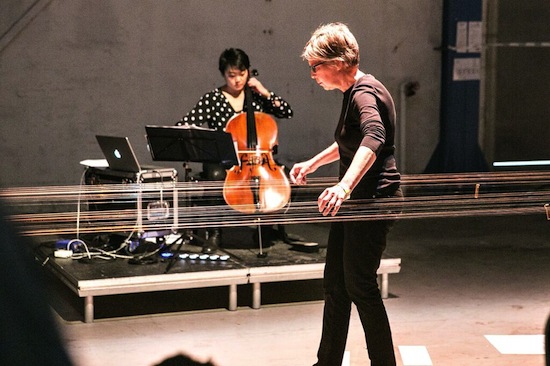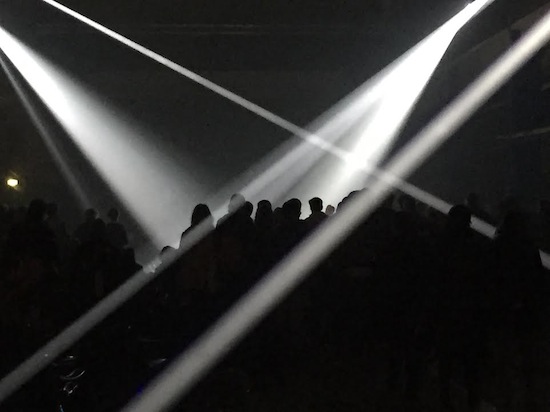As I disembark the train in Helsingør, a mere hour’s train journey north from Copenhagen airport, it’s sobering to think just how quick that trip was. It takes longer (and more often than not costs more) to get on the train down to Cornwall from bloody London. Only this morning I was in my standard issue overpriced flat, and now I’m staring up at Hamlet’s very own castle in the north of Denmark, the coast of Sweden visibly peaking out from behind like a cheeky toddler. When asked the ancient question as to which superpower I would choose, flight or invisibility, I’ve always gone for the former. However, with now ubiquitous technologies, we’re all potential superhumans, able to chat with loved ones halfway round the world quicker than even Superman could manage. It is our artists – specifically musicians – that are already living out lives on stage as technologically enhanced superhumans. They are Tony Starks and Batmen, sculpting gadgetry into sonic weaponry to fight the aesthetic evils of conservatism and, worst of all, boredom and drabness. For 24 hours straight in the old shipyard at Helsingør, Click Festival is to present me with a powerful string of such musicians, "a sensational storm of music" they say, "which challenges the traditional dimensions of festivals".
Soon after arrival, I head out for a stroll along the stunning shores of Helsingør, drinking in a sky riddled with pinks, oranges and blues as the sun sets and shadows begin to take over from the Swedish horizon. Knowing what lies ahead tomorrow (the 24 hour marathon of music I feel foolishly compelled to try and see in full), I grab an extra long kip at my hotel, rise in time for an oversized breakfast buffet (the Danes do this part rather well it’s got to be said – breakfast seems to be almost religiously revered) and nip straight into the theatre in the Kulturværftet (Culture Yard) at noon for my first act. The music stages are warming up with DJs, but in the Kulturværftet’s theatre space I’m treated to a dreamy performance by a Taiwanese theatre troupe. Two young men interact directly with the audience via the internet. I was one of the lucky few chosen on the way in to partake in this side of the show, so I virtually friend one performer via Facebook, and we begin to chat, our conversation embarrassingly projected at the back of the stage for all to see. The performance, rather sweetly titled Teatime with Me Myself and I takes an utterly uncynical approach to communications technology. It really views networked screens, cameras and phones as a launch pad for creation; a true asset to the artist’s potential arsenal.
Next I head to the warehouse in the shipyard next door. It’s a huge former industrial space, a storage room with enough capacity for an entire naval fleet. Rhys Chatham relatively early set in the space is a real triumph. This is the third time in a year I’ve encountered Chatham, and last year I was confronted by an intimate solo performance, looping trumpet blasts that amassed like the buzzing of flies, atonally slashing at the eardrums, but lacking the gigantic scope of his signature pieces for guitarmies of hundreds. That’s all changed though now, and this newly fleshed out version of that same embryonic composition is a true sight to behold. Chatham’s joined on stage by Danes Jeppe Skovbakke on bass and Rune Kielsgaard on drums. Layers of trumpets gather from Chatham, and the bass creates a rumbling undercurrent while polyrhythmic drumming fills any remaining vacant space. A gigantic screen behind plays silhouetted landscapes in warm reds and oranges. In oddly Chathamesque fashion, sweetness emerges and a manic Albert Ayler-esque militarism reveals itself. Keiji Haino – the Dark Prince himself – is seated near the front, and seems to break character for a moment to headbang joyfully along as things hit a new level of awesomeness. Later Chatham swaps horn for guitar, and again for bass flute, adding slowly plucked chords and windy flutters to the mix. It’s an amorphous web of criss-crossing serendipity, in many ways mimicking his own guitar orchestras like an approaching oil tanker. This is quite likely Chatham’s finest work ever, and it demonstrates the sheer power of the relatively humble loop pedal setup. Chatham no longer needs to employ a cast of hundreds to make his signature music of superhuman proportions.
Next, CTM appears. It is the project of Cæcilie Trier, who’s tellingly been released on Tambourhinoceros, the same label as Quietus favourite, Frisk Frugt. Trier stands boldly at the centre of a near-empty stage for a bizarre half hour set of semi-present downbeat futurist pop music. There’s plenty of odd sampling – including what sounds like a game of squash, oddly bouncing balls around the gigantic hall we’re in – along with some effects pedal wizardry and counterintuitive piano playing from a collaborator to her left. The music is however staunchly centred around Cæcilie Trier’s powerful singing, and she seems to grow ten times in size, infecting the hall with a potent, inexplicable energy. Marching Church later bashes out a set of pungent aggressive singing, almost identically matching the spirit of the Nick Cave seen in Wings of Desire, angrily laying down tune after tune, backed up by a host of killer instrumentalists.
While Ellen Fullman’s story (art student who moved to NYC in the early 80s and collaborated with the likes of Pauline Oliveros…etc etc) is hardly unique, her methodology absolutely is. Her Long String Instrument lives up to its name, and as we exit the large hall for an adjasent room which has been set aside just for Fullman’s needs, we’re instantly confronted by the sight of the 90-foot long metal strings, stretched between two far apart wooden boxes, Fullman standing inbetween the strings, arms outstretched like a child playing airplane. She walks slowly forwards and backwards, running her hands across the strings, caressing them rather than pulling them, and ghostly tones fill the air between the walls as the 90ft strings vibrate, their sound creeping into every recess and nook available. Theresa Wong (a veteran of Zorn’s Tzadik label) joins Fullman, crafting complimentary drones and a solid low end of loops via her cello as Fullman populates the upper registers. Fullman is reading notes strategically strewn across the floor throughout her performance as she walks past them, and the mood shifts imperceptibly slowly from sleepy to nightmarish to heavenly. Wong leaves her cello behind, heading to the far side of Fullman’s instrument. They march gradually towards each other, meet in the middle and cross paths, and the sound dies out when they stop at either end. Fullman’s custom made bit of technology has elevated her to somewhere beyond the realms of human possibility, sonically augmenting her and temporarily the very fabric of the space itself.

Keiji Haino’s solo performances have been noisy affairs since as far back as the 1970s (check out Ama no Gawa ("Milky Way"), an outright noise recording dating back to 1973). Away from the realms of his atomic-powered freeform power trio Fushitsusha, his guitar playing has been the harshest and noisiest it possibly can as a matter of standard. He walks out on stage into a packed out room of excitable Danes and Swedes, picks up his Gibson SG and instantly unleashes a tirade of earsplitting feedback. It’s at this point I realise I’m standing directly in front of the man and his three amplifiers with no earplugs of any kind. Oh shit. After a few minutes though, saying goodbye to my hearing feels worth it just to feel the full force of a man possessed. Haino appears to be pouring his very soul into the pickups, setting himself aflame for all in attendance to look on bemused.
Previous solo guitar outings for Haino have seen him perform in various capacities, but ‘noisy’ has been always his signature default, perhaps typified by early 90s recordings, Affection and Execration That Accept To Acknowledge. The odd thing about Haino – in light of my theme up to here – is how little he’s changed. Tonight, his guitar is channeling through a variety of loopers, fuzz pedals, distortion pedals, while he at one point switches entirely to digital theremins (a still relatively new addition to his gear), conducting his hands above them like a crazed druid. Despite expanding his gear massively since the brutalist likes of Execration, the outcome and sound are very similar, and just as powerful. He’s an exception to the rule (as always), and proof that some people are just born superhuman – inaugmentable. I manage to snap the below photograph of the master at work without embarrassing myself. Afterwards I take a brief rest – at least until the ringing in my ears dies down a little.
Deep into the witching hour part of the evening, an indefinable performance titled Silicium by two Danes – producer Bjørn Svin and visual artist, Carl Emil Carlsen – proves itself to be an unlikely highlight. In another side room from the main hall (dubbed the "4D Box"), I arrive too late to claim a pair of 3D glasses, but nonetheless wind up stunned by what I witness. Bjørn Svin’s crazed electronic score guides a dancer through a solid half hour of incessant movement on a holographic stage, and seemingly 3D shapes and washes of cell like digital micro-organisms float around the dancer’s body. The dancer and holograms interlock, quite literally augmenting each other into something more than human. The below video taken from last year’s Click festival should give you some idea. I managed to persuade a fellow punter to loan me their 3D glasses, and it’s almost impossible to believe what you’re viewing is real – which of course it only sort of is in its way.
If this were one of those articles where a young person spends 24 hours in an ASDA, watching the crazed dregs of society weep their way through commercial churches of misery, this would be the part where things get a bit weird at about 3am. British dark ambient legend and friend of Throbbing Gristle, Lustmord, takes things to another level in the very same space Haino had earlier screeched with high end eardrum piercing noise, choosing rather to bottom out the low end from his laptop. He coerces the speakers to rumble and shake uncontrollably, and gaping chasms of round edged bassy ambience threaten to tear the building to shreds. We lie down on the floor, and Lustmord’s tones quite literally massage our bodies, shaking every inch of our bodies. It’s unlike anything else I’ve ever heard, putting the likes of Sunn O))) to shame, sending hell’s own demons running for cover. The crowd disperse, but the music goes on, and things get hazy. I must power on though – Lee "Scratch" Perry is playing with the Mad Professor in a few hours…

Outdoors, sunlight arrives over the same Swedish horizon that gave us darkness the night before. The few surviving members of the crowd are exhausted, but slowly our numbers grow, and the heroic DJs even get a few people dancing again. In the main hall, a gigantic sound system is getting set up, a towering mess of wood, metal and black plastic, like some futuristic Maginot line fortification. Guyanese dub legend, Mad Professor, mans a stack of gear in between the two tank-like sides of the soundsystem, and toasts his way through a killer set of classic dub tracks. Eventually, the nearly 80-year old Lee "Scratch" Perry takes the stage, and godlike vocalises his ills with the world. It’s a welcome finale to an exhausting night. Click can proudly place itself on the growing list of European festivals that are pushing real boundaries. It’s an unforgettable experience, greater than the sum of its parts.


